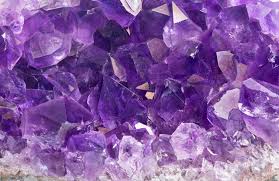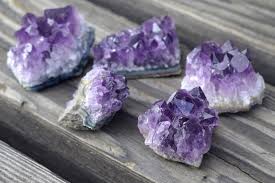For people born in February, their sole birthstone would be Amethyst— a gemstone that is synonymous with purple. Amethyst is a variety of quartz which was once prized highly and valued above emerald and ruby. As a matter of fact, this February Birthstone was known in ancient times as one of the 5 cardinal gemstones. Large Amethyst deposits were found in Brazil during the 19th century and the country continues to produce a great abundance of this gemstone.
Though the supply causes a decrease in price, Amethyst has not diminished its beauty and remains to be the most-sought after quartz variety.
Table of Contents
- What’s The Color of The February Birthstone?
- February Birthstone: Amethyst Etymology, History, and Folklore
- The Spiritual Meaning of February Birthstone
- The Health Benefits and Healing Properties of the February Birthstone
- Durability of the February Birthstone
- Caring and Cleaning February Birthstone
- How To Store Amethyst?
- The Cost of February Birthstone
- Amethyst Alternative: Secondary February Birthstones
- Conclusion
- Related Reading
What’s The Color of The February Birthstone?

Like most gemstones, the Amethyst name is used to refer to its specific color frequency between violet and purple. However, there’s more to this gemstone color palette
The hue and tone of Amethyst can vary, ranging from a deep purple to light pinkish violet with hues of blue and red sometimes occurring.
These colors can be so subtle and light that they’re nearly vague or so dark that the stone looks opaque.
The lighter-toned Amethysts are used for mass commercial productions while the rare, premium reddish-purple ones are reserved for the designer jewelry. A deep purple color variety with blue and red flashes called the Siberian Amethyst has the highest price tag on the market.
Here are some descriptions of an Amethyst color:
- Plum or Raspberry for reddish colors
- Royal, Indigo, or Grape for darker colors
- Lavender or Orchid for lighter tones
When heated, an Amethyst gemstone can turn yellow-orange, yellow-brown, or darkbrownish. Brazilian Amethyst, in particular, is usually heat-treated in order to create citrine and ametrine (mix of citrine and amethyst with the orange or yellow and purple color zone) when partially heated.
Get A Free Downloadable Checklist of The 3 Best Crystals For Healing Each Of Your Chakras.
Give Me My Free ListFebruary Birthstone: Amethyst Etymology, History, and Folklore

The name Amethyst comes from the Greek term “amethystos” which means not intoxicated or drunk”. The Greeks gave this name in the ancient belief that wearing this gemstone or drinking from a cup with Amethyst can protect you from becoming drunk as well as acting a powerful antidote to intoxication, due to the color resembling that of wine.
Another myth that is associated with Amethyst is the Dionysus, the Greek God of Winemaking who has suffered an insult from a mortal. Angered, he swore to slay the next mortal who would cross his path with savage tigers of his creation.
That mortal was a beautiful maiden, Amethystos on her way to tribute to the Goddess of the Hunt, Artemis. Artemis took pity of her loyal devotee and transformed her into a statue of crystalline quartz in order to protect and defend her from the ripping claws of tigers.
After looking at the statue himself, the god of winemaking wept tears of wine and stains the quartz which gave Amethyst its purple color.
Furthermore, Amethyst was also believed to keep its owner quick-witted and clear-headed in battle and business, prompting the medieval European soldiers to wear it as a protective amulet
Additional Info
In ancient Hebrew, Amethyst was known as the “ahlamah” which is the ninth of the 12 gemstones representing the tribes of Israel. It is believed that this stone represented the Tribe of Dan, also known as Judges.
Meanwhile, the Christian tradition sees Amethyst as a symbol of clergy and royalty, especially the bishops who wear Amethyst in their ecclesiastical rings for protection from mystic intoxication. In addition, Amethyst was also known to adorn wine goblets of the nobility and clergy alike, guarding them against alcoholic intoxications.
The Egyptians call Amethyst “hemag”. Listed in the Book of the Dead, they are taught to carve it into heart-shaped amulets and should be placed inside burial tombs. Meanwhile, in eastern philosophies, this gemstone has long been used in temple offerings and creating breaded prayer rosaries. As a matter of fact, the Tibetans, to this day holds Amethyst as a sacred stone to Buddha and carve their prayer beads from it.
The Spiritual Meaning of February Birthstone

Starting from its most characteristic color— the purple— you will find that Amethyst has strong connections to magic, mystery, luxury and power. The color purple contains the strength and energy of red as well as the integrity and spirituality of blue— symbolizing the union of soul and body and creating a balance of your spiritual and physical beings.
In addition, Amethyst is the birthstone for both Pisces and Aquarius. And these two signs encompass key personality traits that vary from being adventurous and charming to having deep love, sensitivity, and creativity. Thus, it’s no surprise that the February birthstone embodies such spiritual virtues as well.
The purple and blue shades of the gemstone also directly tie it to the higher chakras— the crown chakra (violet), the 3rd eye chakra (indigo) and the throat chakra (blue).
Such energy nodes are the seats of spiritual connection, wisdom, and communication, respectively. And Amethyst stimulates your higher mind in order to receive spiritual power and opens one to wisdom, insights and guidance that flow from such power.
Lastly, Amethyst has a strong connection to marriage. It is traditionally given during the 6th wedding anniversary of couples. And numerologists speak of the 6-cycle of life, where different phases of change and growth occur. The 6th year emphasizes matters of the heart and love, especially something about children, family and marriage.
The Health Benefits and Healing Properties of the February Birthstone
As mentioned before, Amethyst has this ability to cure or prevent intoxication during ancient times. Such intoxication was mainly because of alcoholic drinks. Today, however, addiction and intoxication are more than just alcoholic beverages.
In addition to treating alcohol addiction, this gemstone is also known to treat addiction to amphetamines, opioids, and tobacco. Furthermore, it helps calm the temperament of an individual who constantly finds themselves addicted to sex, adrenaline sports and gambling.
A well-known tranquilizer, the February gemstone can help soother the mind of hyperactive kids as well as those suffering from obsessive-compulsive disorders, curing insomnia and promoting nice dreams.
In terms of the physical body, Amethyst regulates the endocrine glands and the production of hormones while also stimulating the sympathetic nervous system. In addition, this stone is known to strengthen your immune system aids in the treatment of the skin, digestive system and heart, reducing inflammation and related conditions and supporting good oxygenation of the blood.
Not only that, but the Amethyst is also used to cure and treat ailments of the ethereal body and offers psychic healing as well as the protection of energy fields. Used for spiritual cleansing, Amethyst can remove darkness, and boosting your positivity shield.
Lastly, the connection of this birthstone to the higher self of spiritual understanding and wisdom makes it a powerful healing crystal for those grieving the loss of a loved one. It helps release your sorrow and empowering you to understand that death is just a transition of the spirit.
Durability of the February Birthstone
The concept of the durability of a gemstone is comprised of 3 factors: its resistance to scratching (hardness), its resistance to breakage, cracking and chipping (toughness) and its resistance to environmental or chemical shock (stability).
Amethyst Hardness
Being a quartz variety is considered a hard stone. As a matter of fact, it is rated 7 on the Mohs hardness scale. Thus, only gemstones higher than 7 can scratch Amethyst like a diamond. Furthermore, Amethyst poses a threat to sifter gems, thus it is recommended to be stored separately from other gems.
Amethyst Toughness
The February birthstone is considered to be a durable gemstone, appropriate for all pieces of jewelry from necklaces, bracelets to earrings and rings. However, Amethyst is considered to have good toughness.
Thus, it is important to take proper care when cleaning or wearing them so that they won’t break or chip.
Amethyst Stability
Amethyst is very stable, however, it can have fractures when subjected to rapid changes in temperature. Prolonged exposure to intense light can also cause color fading. In addition, spot removers, de-greasers, ammonium fluoride, hydrofluoric acid and alkaline solutions like metal polishes and bleach can damage the gemstone.
Caring and Cleaning February Birthstone
How To Clean Amethyst?
You can simply clean an Amethyst with a soft brush and soapy water. In addition, ultrasonic cleaners can be used to clean the gemstone, except for the very rare case that’s been fracture-filled or dyed.
Meanwhile, a steam cleaner should never be used to clean the gemstone since Amethyst doesn’t do well at high temperatures.
How To Store Amethyst?
Amethyst is sturdy enough to survive the odd knocks and bumps on a hard surface. But, you still need to take care of it. This is why it is recommended to remove your pieces of jewelry before any physical activities especially when gardening or cleaning.
Because of its hardness, it is important to keep it away from softer stones or harder stones in order to prevent scratches. Consider storing the Amethyst on a different fabric-lined compartment on your jewelry box. In addition, individual cloth jewelry bags make also be suitable if you have limited space in your jewelry box.
Diamond papers or parcel paper envelopes are another great space-saving storage method. Meanwhile, glass jars with fabric inserts or foam are perfect in showcasing loose gemstones.
The Cost of February Birthstone
Amethyst is commonly found in faceted ovals and rounds and the prices don’t tend to exponentially climb above 1 carat like most precious stones.
AS a matter of fact, an 81-carat oval can be purchased under $500. Meanwhile, the smaller 24-carat octagonal cut can be taken for just $150.
A pair of 3.6-carat pear facet earrings will be yours for at least $50. In addition, bracelets and necklaces with a 15-piece set of 0.6 carats can be yours for just $60.
In addition, Amethyst geodes also make poplar home decors and an 80-carat crystal cluster geode can have a price of $80.
Amethyst Alternative: Secondary February Birthstones
According to the birthstone list of 1912 Jewelers of America, pearl and hyacinth (the ancient name of zircon) were considered alternative February birthstones.
Today, however, Amethyst is the exclusive and primary birthstone for February. Instead, those who were born in the Aquarius zone of February can adopt garnet as an alternative birthstone.
Conclusion
As the second month of the year, February represents excitement and energy that comes from growth and change. And Amethyst can help calm down an active mind, cleansing the spirit and body and connecting you to your higher self.
As a variety of durable quartz, this soothing stone in all its charm and splendor makes an outstanding choice for people born in February. Not only that, it is quite abundant and you get to choose from a variety of shapes and cuts with the most reasonable prices.
Related Reading
Felicia Eisnnicher
I am the Lead Author and Editor at Gemstagram. I am responsible for creating and editing content about the power of gems and crystals. I also teach about self-knowing, self-understanding and personal empowerment through numerology. My mission is to help people understand the power of gems and crystals, and how they can use that power to improve their lives. I believe that by understanding ourselves better, we can become more empowered individuals who are able to create our own destiny.Visit my profile page for more information about me: Felicia Eisnnicher Author Profile
Get A Free Downloadable Checklist of The 3 Best Crystals For Healing Each Of Your Chakras.
Give Me My Free List

